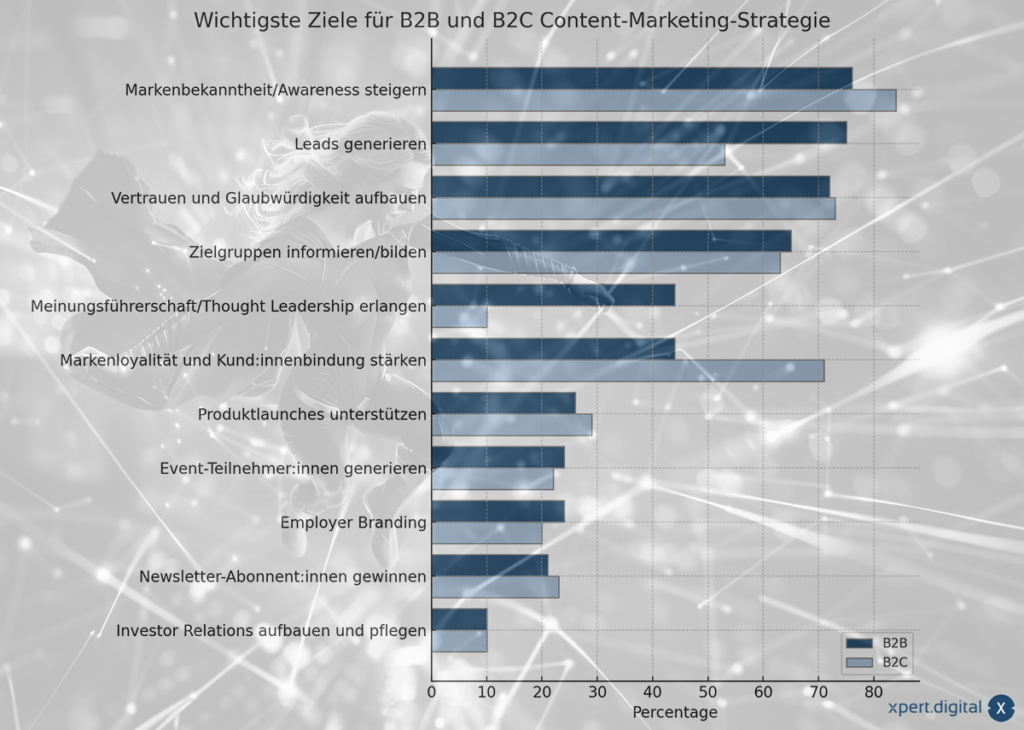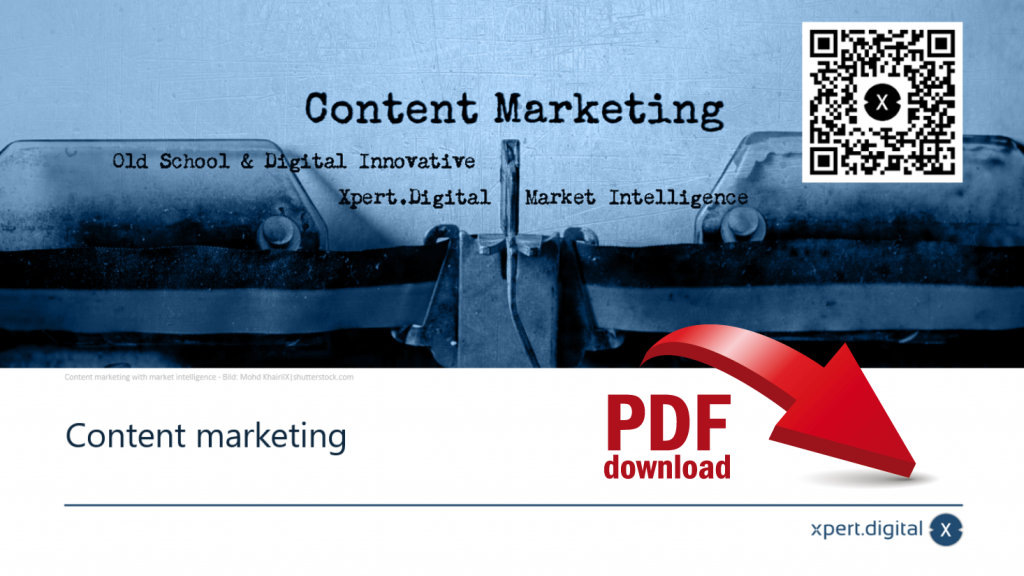Published on: October 20, 2024 / Update from: October 20, 2024 - Author: Konrad Wolfenstein

When is content high-quality content and particularly valuable for both search engines and users? – Image: Xpert.Digital
10 characteristics for top content: How to inspire readers and search engines
In the digital world, where tons of content is published every day, it is crucial to stand out with high-quality content. But what exactly makes content really valuable? High-quality content should not only attract readers' attention, but also be optimized for search engines so that it ranks well in search results. The balance between useful, relevant information and technical optimization for SEO (search engine optimization) is crucial. Below we describe ten key characteristics of high-quality content and explain why they are important to both users and search engines.
Suitable for:
1. Relevance and usefulness
Arguably the most important aspect of high-quality content is relevance. Content must meet the needs and expectations of the target group. If a user is looking for a specific piece of information, the content should answer that exact question or solve a specific problem. Content that is relevant and offers real added value increases reader satisfaction and promotes loyalty to the brand or company.
A good content ensures that the reader is provided with practical and implementable information. For example, an article about “10 tips for improving search engine placement” could not only offer general advice, but also concrete measures that the reader can apply immediately.
2. In-depth research
High-quality content is the result of thorough research. Superficial information or general statements quickly appear unprofessional and can undermine the trust of readers. Well-researched content, on the other hand, provides well-founded information and proves to the reader that the author is an expert in his or her field.
During the research phase, it is important to consult various sources to paint a comprehensive picture of the topic. This depth is evident in the content and offers users the opportunity to delve deeper into a topic. The use of statistics, quotes from experts and current trends can significantly increase the credibility of the content.
3. Originality
Plagiarism and simply copying content from other sources not only harms SEO performance but also the credibility of the author. Search engines like Google detect copied content and demote it, meaning such pages rarely appear in the top results. Originality is therefore a decisive factor for placement in search results.
Additionally, users value original content that offers new perspectives or unique information. Content that is creative and different has a higher chance of being shared and recommended. This means that original content can not only perform well in search results, but also spread across social networks.
4. Structure and readability
A clear structure is essential to guide the reader through the text. Long, confusing texts without paragraphs or subheadings are intimidating and can cause the reader to quickly leave the page. High-quality content is logically structured, easy to understand and uses clear paragraphs and meaningful subheadings.
Using lists, bullet points and short paragraphs makes the content easier to consume. The use of multimedia elements such as images, videos or infographics can also help to break up the content and make it more interesting for the reader.
5. SEO optimization
High-quality content must be optimized for search engines to be visible. This does not mean that the text should be overloaded with keywords, but rather that relevant keywords should be specifically included. Keyword stuffing, i.e. excessive use of a specific keyword, appears unnatural and is even penalized by search engines.
Suitable for:
In addition to placing keywords, a good SEO strategy also includes optimizing meta titles, meta descriptions and URL structures. In addition, internal and external links should be included in order to promote the networking of the content and to provide the reader with further information. Page loading speed and mobile optimization are also important factors that influence SEO performance.
6. Timeliness
Outdated content quickly loses relevance and can even be harmful, especially if it is based on outdated or incorrect information. Regular content updates are therefore essential to ensure that the content remains current. Search engines often prefer current and regularly updated content as it is considered more relevant.
It is recommended that you periodically review and update existing content as new information or developments become available. This not only signals to search engines that the content is curated, but also shows the reader that the company or author is making an effort to provide relevant and up-to-date information.
7. Trust and credibility
Trustworthy content is supported by the inclusion of reliable sources, correct information and clear statements. When the reader feels that the content is based on solid data, the credibility of the author or brand increases. This promotes long-term customer loyalty and strengthens trust in the brand.
In today's information overload, it is crucial to create content that is reliable and truthful. Misinformation or unclear sources can damage trust in the content and have a long-term negative impact on the brand image.
8. Interaction and engagement
High-quality content encourages interaction. Be it through comments, likes or sharing on social networks – interactive content promotes reader engagement and increases reach. Addressing the reader directly, asking questions, or offering surveys can help the reader interact more actively with the content.
In addition, the dialogue with readers increases the time spent on the website and improves the user experience. The longer a reader stays on the page, the better the search engine ranking will be.
9. Multimedia content
Text-based content is important, but visual and multimedia content is becoming increasingly important. Images, videos, infographics and interactive elements such as quizzes or surveys make content more attractive and easier to understand. They help the reader grasp and absorb complex information more quickly.
Multimedia content has the advantage that it not only increases readability, but also increases the likelihood that the content will be shared on social networks. Videos and infographics in particular have the potential to go viral and achieve a high reach.
10. Emotional appeal
Content that creates an emotional connection with the reader is often particularly successful. Emotions play an important role in deciding whether to share or recommend content. Storytelling, personal anecdotes, or evoking specific feelings such as joy, compassion, or curiosity can help the content leave a lasting impression on the reader.
An emotional approach also promotes identification with the brand. When the reader feels like their needs and feelings are understood, they are more likely to form a positive connection with the brand or company.
The balance between usability and SEO
High-quality content is characterized by being optimized for both the user and search engines. Relevance, originality and readability are just as important as technical SEO aspects. Ultimately, what counts is the ability to deliver useful and well-prepared content that offers the reader added value while meeting search engine requirements.
In a world where content can make or break a business, it is essential to focus on quality over quantity. High-quality content leads to higher interaction rates, improves visibility in search engines and strengthens customer trust in the long term.
- A representative analysis clearly shows that increasing brand recognition and awareness is the primary goal of content marketing strategies in both the B2B and B2C sectors - Image: Xpert.Digital
- User-generated content – PDF download
- Digital Content Marketing & Public Relations – PR Agency – Public Relations – Image: Eleonora Grunge|Shutterstock.com
- Digital Content Marketing & Public Relations – PR Agency – Public Relations – Image: Roman Samborskyi|Shutterstock.com
- Most important goals for B2B and B2C in the content marketing strategy: increasing brand awareness, awareness and visibility - Image: Xpert.Digital
- Content Marketing – PDF Download
The role of content quality in SEO and improving user experience
Search engine optimization (SEO) is an essential part of digital marketing. Companies that want to achieve high visibility in search results need to understand and implement the various aspects of SEO. Content quality plays a central role. But what does “content quality” actually mean in the context of SEO? And how can it help improve the user experience?
Content quality as a crucial factor in SEO
Previously, SEO was mainly influenced by technical factors such as keywords, meta tags and backlinks. But the modern algorithms of search engines like Google are placing more and more emphasis on high-quality content. Google itself has emphasized that “high-quality, relevant and informative content” is one of the most important requirements for good placement in search results. Why is that?
Relevance and benefit for the user
High-quality content is content that offers users added value. They answer questions, solve problems and provide comprehensive information on a specific topic. Search engines, especially Google, have designed their algorithms to recognize and reward exactly this content. The aim is to provide the user with the best possible answer to their search. The following criteria are particularly important:
1. Relevance
Content must be precisely tailored to the user’s search query. This means that the text should not just address the topic superficially, but should cover it comprehensively and in depth.
2. Originality
Duplicate content is penalized by Google. Only original and unique content has a chance of ranking well in search results.
3. Trust and credibility
Content should be based on reliable sources and written by experts or competent authors. Google gives higher ratings to websites that are considered trustworthy.
4. Timeliness
Especially when it comes to topics that change regularly, such as: B. News or technical innovations, it is important to constantly update content.
Overall, it can be said that search engines are getting better and better at recognizing which content is actually of value to the user. This makes content quality one of the central elements of successful SEO strategies.
How does content quality affect ranking?
There are several ways in which quality content directly or indirectly influences search engine rankings:
1. User retention
Contents that the users like ensured that they stay on a website longer, call up several pages and return less quickly to the search result (this is called "pogo sticking"). For Google, these behaviors are a signal that the page offers users added value, which positively influences the ranking.
####2. Share and link
High-quality content is more likely to be shared on social media and linked from other websites. Backlinks are a crucial ranking factor for search engines because they act as “recommendations” from other websites. The more high-quality links a page has, the better it will be ranked.
####3. User Experience (UX)
High-quality content contributes significantly to improving the user experience. If the user finds the information they are looking for quickly and easily and has a positive interaction with the website (be it through good navigation, short loading times or an attractive design), this has a positive effect on the ranking. Google measures these “user signals” (e.g. length of stay, click rate) and uses them to evaluate the website.
Improving user experience as part of SEO
In addition to the quality of the content, the user experience also plays a central role in SEO. Google and other search engines are committed to promoting not only the best content, but also the best user experiences. But how can the user experience be specifically improved as part of SEO?
1. Optimize page loading speed
One of the first measures to improve the user experience is to optimize loading times. Nobody likes waiting several seconds for a website to fully load. Research shows that users quickly abandon websites that take longer than three seconds to load. A high bounce rate signals to search engines that the website is not relevant or user-friendly for users. The following measures can help shorten loading times:
- Compression of images and videos
- Use of browser caching
- Minification of CSS and JavaScript
- Using a Content Delivery Network (CDN)
2. Mobile optimization
With the rise of mobile usage, it is essential that websites function optimally on all devices, especially smartphones. Google has been using “mobile-first indexing” since 2018, which means that the mobile version of a website is used as the primary basis for ranking. So a site that isn't mobile-optimized will perform worse, even if it looks good on desktop.
Good mobile optimization includes:
- A responsive design that adapts to different screen sizes
- Easy-to-read text without zooming
- Easy navigation and scrolling
- Clickable elements that are large enough to easily operate on mobile devices
3. User-friendly navigation
Intuitive and well-structured navigation makes it easier for users to find their way around the website. This not only has a positive impact on the user experience, but also helps search engines better capture and index the content of the page. Important aspects are:
- A clear menu structure
- A clearly visible search function
- Links to related content
- “Breadcrumbs” that show the user the way through the website
4. Structured data and rich snippets
Structured data is a way to provide search engines with additional information about the content of the website. This information can then be displayed in the form of “rich snippets” in search results, significantly increasing visibility and click-through rates. Examples of structured data are reviews, product information or event data.
By using structured data, a website can stand out more in search results and offer users added value before they click, e.g. B. by displaying reviews or price information.
5. Write content for users, not search engines
While it is important to follow basic SEO rules, the focus should always be on creating content that is valuable to users. Search engines now recognize whether content was created just for ranking or whether it actually offers added value. For a long time, it was common practice to over-optimize keywords, i.e. to include them in the text as often as possible in order to perform better in search results. But such tactics are increasingly penalized by modern search algorithms.
Instead, the focus should be on writing content that:
- Are understandable and well structured
- Answer users' questions completely and accurately
- Naturally integrate relevant keywords and related terms
6. Use visual elements correctly
Visual elements such as images, videos or infographics can significantly improve the user experience. They make content more appealing, easier to understand and increase the time users spend on the website. However, when using visual content, it is important to ensure that it does not negatively impact page load times. Images should also always be tagged with relevant alt tags to help search engines understand the image content.
Quality of content and user experience
Content quality and user experience are crucial factors for SEO success. While the focus used to be on technical aspects, modern search engines are now getting better at recognizing which content is actually of value to the user. Companies that focus their SEO strategies on high-quality, relevant content and a positive user experience will benefit from better rankings and higher visibility in the long term.
In summary, high-quality content tailored to users' needs, combined with a user-friendly website that loads quickly and works well on all devices, is the key to a successful SEO strategy.







